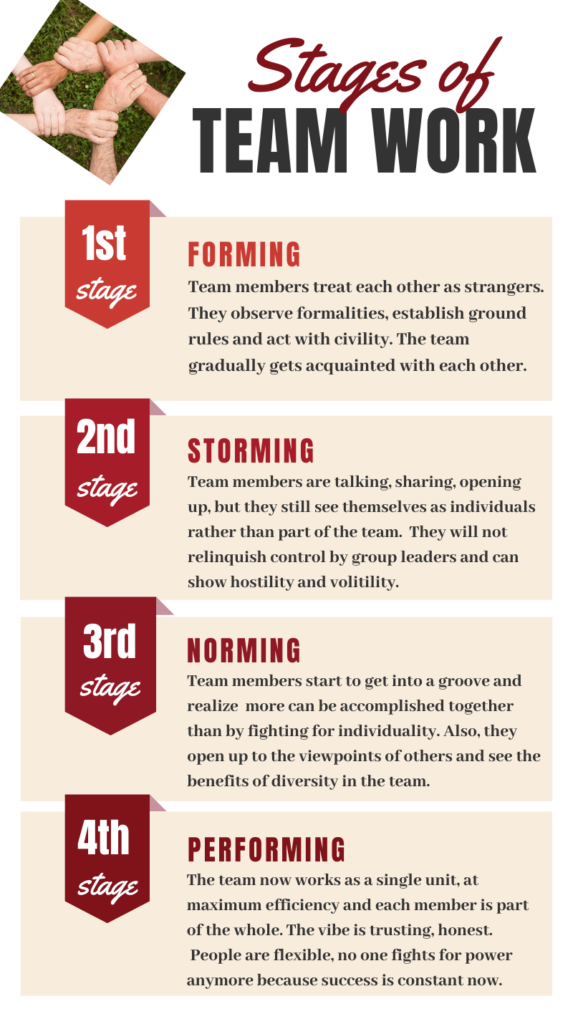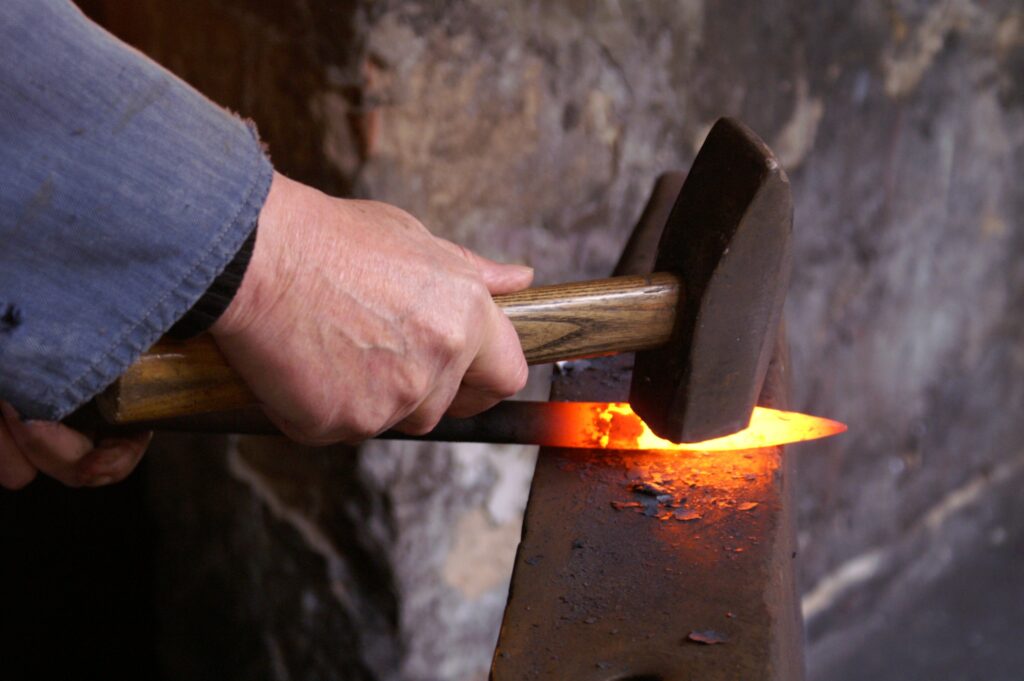
Putting the Work into Teamwork, One Stage at a Time
All too often, I’ll get a call asking for information about people wanting to build strong teams through team building. It goes something like this:
“Yes, hello! My team and I are interested in doing a team building i at your location in about three weeks. There will be 25 of us. We have around an hour between the last meeting of the day and our dinner reservation. Can you give me some options?”
It sometimes takes everything I have to let them know that incredible teams aren’t built between the last meeting of the day and the dinner reservation. But I do my best to give them what they seek.

In case you’re short on time or attention, here’s the TL;DR:
Back in 1965 when I was still toddling around in diapers, an American psychological researcher named Bruce Tuckman made up his mind that there were four stages that made up a model for group development: forming–storming–norming–performing. Bruce went on to hypothesize that each one of these phases were necessary and inevitable for a team to mature, analyze problems, design solutions, implement work, and evaluate results.
- Forming is when the team first gets together.
- Storming is when they’re in conflict, not getting along and fighting for position.
- Norming is when they’ve finished deciding what is “normal” for them.
- Performing is when they are finally working together like a well-oiled machine.
Note: anytime anything about the team changes (someone new is introduced to the team, someone on the team leaves, etc), the entire process begins again at Forming.
Are you still with me? If so, and if you’re interested in a deeper dive, come along with me while we peek behind the curtain and see what really goes into building a solid team. If you stick with me, you’ll see that it’s way more than just a bunch of high fives and fist bumps after a company sponsored bowling outing followed by Apple-Tinis at the pub down the street. You may even pick up a thing or two that will help you build better teams when we’re finished here. So let’s start at the beginning.

The Forming Stage
The first step when trying to build strong teams starts when you first meet your new team. When teams first get together, this is called the Forming Stage. The Forming Stage is a segment of time where people get acquainted. I specifically say acquainted because no one really gets to know each other yet, and the formality of the word acquainted fits much better here. Imagine the first day at work with a bunch of other new hires you have never met. That’s not great, but it could get worse. Imagine this: you’re the brand new person thrown into a team that you are told is already highly functioning and you need to “get up to speed as soon as possible”. Sure, no problem, boss! Anything else, or just that impossible Day One task?
The Forming Stage can also occur when team members are disrupted by the loss/termination of one of their prior team members, and now they have to figure out a New Normal without that key player.
Basically, think change.
Whenever anything changes in a team, you’re back to Forming and the cycle starts anew.
This stage is always formal, stilted and awkward. As in, first date awkward. People aren’t sure how to say your name correctly and you have to, again awkwardly, correct them. My last name is a doozy. It’s Fruchtman. People mangle their lips together making a noise that sounds like “pooch” with an F. I let them struggle for only a moment before I smile and say, “it rhymes with Truck Man” and then everyone breathes a sigh of relief.
Uncertainty and distrust is high during this stage, and people are looking for leadership and authority. Any team member who shows the courage to speak up, or who may seem knowledgeable may be expected to take control. That’s how you can end up as Foreman of the jury sometimes – you’re the first person dumb enough to break the silence, and suddenly, you’re in charge.
Everyone is wondering the same thing, but few are willing to say so out loud. Here’s what’s going on in people’s heads: “What’s in this for me if I go all in with this team?” “What do they think I can bring to the team?” “What if I don’t fit in?”
Small talk eventually leads to commonalities, commonalities lead to more relaxed conversations, and with luck, everyone has some sort of daily job while all this is happening so the weirdness of the new team isn’t too weird for too long. Eventually, and it doesn’t take that long, people relax and slowly see that everyone else shares the same fears and insecurities about fitting it, about their contribution to the group, about what’s in it for me, and things start to settle as alliances and cautious friendships begin to form.

The Storming Stage
The single most challenging and critical stage of amazing team building is the Storming Stage. Depending on your unique blend of personalities, it could be a little rocky, or it could be a drama-laden phase peppered with sniping, back-biting, and cutthroat competition that makes an episode of The Bachelorette look like a paint and sip. As people’s personalities begin to surface, the team’s performance and productivity is likely to diminish. It’s one of those “things get worse before they get better” stages. Time and effort and used on counterproductive activities such as petty disagreements, the sudden clash of strong personalities, the formation of cliques and the inability to agree on the same team goals. Teams can easily get stuck in this stage. The team’s inability or refusal to manage conflict resolution at this stage will almost assure problems down the road.
To survive these growing pains, team members must work hard to keep their eye on the prize, overcome obstacles, which in this case is getting out of their own way, put their own egos aside, try to embrace individual differences, and to work through conflicting ideas on team goals and objectives.

The Norming Stage
Once teams survive the Storming Stage, the dust settles and the team surfaces, albeit with a few scrapes and bruises, but nonetheless, victorious and conflict-free. The road to building stronger teams is a rocky one, but one worthy forging. There is a new sense of uniformity, of trust resulting from having survived something ugly together, and still being alive. Now having arrived in the Norming Stage, harmony develops. Role definition is easier to define and personality conflicts are settled far easier than before. Uniformity, solidarity and at last, increased team performance is on the rise as this stage develops. Team members figure out how to tolerate one another and even enjoy the asset that is their diversity. Targeting goals and enjoying the increased collaboration is the new normal. But caution is advised: the rapport is still fragile, and if disputes rear their ugly heads, our prosperous Norms can backtrack into Storming at the drop of a hat, so it’s critical that everyone keep their egos in check.

The Performing Stage
In this final and wonderful end to the cycle, the Performing Stage, you can see how our little team has been put through its paces, laughed, cried, fought, made up, found normal, and finally, reach a well-deserved nirvana that looks something like the love child of a Pit Crew and a team of Emergency Room doctors. Driven. Committed. Organized. Efficient. Stronger. Better. A Team. With a capital T. Will problems ever arise again? Of course! People are human. But when issues crop up in the future, the team will handle conflict swiftly, constructively and resolutely. They will recognize that there’s no room on this team for drama; this team is focused on one thing and one thing only: problem-solving and meeting team goals.
For historical accuracy, I will mention one final footnote. In 1977, Bruce Tuckman, along with Mary Ann Jensen (a Doctoral student at Rutgers) added a fifth stage to the other four stages: Adjourning. It involves completing the task and breaking up the team. I don’t find this useful since it doesn’t make sense for most teams these days in the modern workplace. Plus, it doesn’t rhyme properly, so it offends my sensibilities. Let’s pretend I never mentioned it.

Wrap Up
How are you going to use Forming, Storming, Norming and Performing to build your teams into stronger, more cohesive co-workers? Will you start by observing and noting when your teams bicker, realize that perhaps they are eternally stuck in the Storming Stage? If so, what will you do to give them a kick in the pants to move on to the next stage? Before any team building activity of a serious nature, it’s best to know at what stage your team is before you go into the activity. Meet your team where they are and recognize that sniping and snark might be de rigueur for a team in the Storming Stage, but a big old red flag for a team who’s well into the Performing Stage and ought to know better. Leave a comment if you’ve used this paradigm, or if you plan to build stronger teams using this method.- –
Learn more about team building at Escape Room Palm Springs.